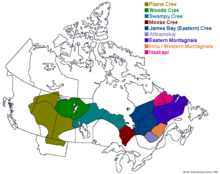Indigenous peoples of the Subarctic

Indigenous peoples of the Subarctic are the aboriginal peoples who live in the Subarctic regions of the Americas, located south of the true Arctic. This region includes the interior of Alaska, the Western Subarctic or western Canadian Shield and Mackenzie River drainage area, and the Eastern Subarctic or Eastern Canadian Shield.[1] Peoples of subarctic Siberia and Greenland are sometimes included in the subarctic; however, Greenlandic Inuit are usually classified as Indigenous peoples of the Arctic.
Languages
Native subarctic peoples have over 30 languages, falling into two major language families: Algonquian and Athapaskan.[2] Algonquian peoples tend to live in the east, while Athapaskan peoples live more in the west.[1]
Arts and cultures
Caribou has traditionally played a central role in Subarctic culture. Besides providing food, caribou provides clothing, shelter, and tools, such as the babiche bag, made of caribou rawhide. Moosehair embroidery and porcupine quill embroidery are worked onto hides and birchbark. After introduction by Europeans, glass beads became popular and are sewn into floral designs.[1] Additionally, some cultures practiced agriculture, alongside hunting and gathering.
List of indigenous peoples of the Subarctic


- Ahtna (Ahtena, Nabesna)
- Anishinaabe - see also Northeast Woodlands
- Atikamekw
- Bearlake
- Chipewyan
- Cree[1]
- Dakelh
- Deg Hit’an (Deg Xinag, Degexit’an, Kaiyuhkhotana)
- Dena’ina (Dialects: Outer Inlet, Upper Inlet, Iliama, Inland, Kachemak Bay, Kenai, Susitna River)
- Dunneza (Beaver)
- Gwich'in (Kutchin, Loucheaux)
- Hän
- Hare
- Holikachuk
- Innu, Labrador and Quebec
- Kaska (Nahane)
- Kolchan (Upper Kuskokwim)
- Koyukon
- Mountain
- Naskapi
- Sekani
- Slavey (Dialects: Hay River, Simpson Providence, Liard, Fort Nelson)
- Tagish
- Tahltan
- Lower Tanana
- Middle Tanana
- Upper Tanana
- Tanacross
- Tasttine (Beaver)
- Tlicho
- Inland Tlingit
- Tsetsaut (extinct)
- Tsilhqot'in (Chilcotin)
- Northern Tutchone
- Southern Tutchone
- Yellowknives